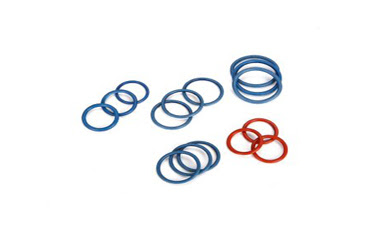Solar Seal Rings: Engineering 25-Year Weathering Resistance
As a manufacturer with 31 years of sealing technology expertise, we understand PV seal rings are not ordinary rubber components—they must protect equipment for 25 years under desert UV, coastal salt spray, and Gobi sandstorms. This article reveals how four core competencies (material formulation, structural design, smart manufacturing, and scenario customization) deliver zero-failure sealing solutions for the solar industry.
I. Extreme PV Sealing Challenges & Technical Countermeasures
- UV Degradation Cracking Failure Consequence: Coolant leakage → PID effect Solution: EPDM + Carbon black shielding layer Validation: QUV 6000h ΔH
- Salt Corrosion Failure Consequence: Aluminum frame electrochemical corrosion Solution: Zn anode-embedded seal rings Validation: 80% corrosion rate reduction (1000h salt spray)
- Sand Intrusion Failure Consequence: Guide rail jamming → 15% power loss Solution: Multi-lip labyrinth + electrostatic flocking Validation: IP6X certification (1m³ dust chamber)
- Low-Temperature Brittleness Failure Consequence: -40℃ installation cracking Solution: Long-chain branched EPDM (Tg=-65℃) Validation: >85% compression resilience at -50℃
- Chemical Swelling Failure Consequence: Seal expansion → frame deformation Solution: FVMQ ester-resistant formula Validation: ΔV<3% (1000h immersion)
II. Material Innovation: Molecular Design to Weathering Formulation
1. PV-Specific Rubber Systems
| Material | Key Property | Application |
|---|---|---|
| High-weather EPDM | Ozone resistance >1000 pphm | Module frame seals |
| Fluorosilicone | Ester solvent resistance | Inverter coolant lines |
| TPE-S | Laser weldable (+50% efficiency) | Junction box seals |
| Conductive silicone | Surface resistance 10³ Ω | Tracker control boxes |
Core Formulation Tech:
- Nano-shield: SiO₂-coated polymer chains → UV transmittance <0.1%
- Self-healing: 5μm polybutadiene microcapsules → crack repair
2. Eco-Certifications
- Non-migrating:
- RoHS 3.0: 11 heavy metals undetectable
- UL 94 V-0: Flame-retardant seals (for ESS inverters)
III. Structural Design: Symbiotic Sealing Topology
1. Scenario-Adaptive Structures
- Double-glass frames: Pneumatic self-adaptive seals → 3x faster installation, 60% fewer microcracks
- Tracker shafts: Dual-lip oil-retaining seals → Maintenance cycle: 1yr→5yrs
- String inverters: 3W/m·K thermal pads → Heat sink temp ↓15℃, lifespan ↑30%
- Floating systems: Closed-cell EPDM foam (0.6g/cm³) → Buoyancy +20%, cost -35%
2. Digital Design Tools
- ANSYS simulation: 2000 thermal cycles (-40℃~85℃)
- AI topology optimization: 15% weight reduction, 10% cost saving
IV. Smart Manufacturing: Zero-Defect Process
1. Quality Control Nodes
| Process | Precision Control | Defect Rate |
|---|---|---|
| Mixing | Mooney viscosity ±3% | |
| Molding | Temp ±1℃, Pressure ±0.2 MPa | |
| Surface treatment | Plasma >50 mN/m | |
| Inspection | 3D vision ±0.05mm tolerance |
2. Rapid Response System
- Modular molds: 2000+ profiles in <1h
- Desert satellite plants: 72h delivery
V. Solution Delivery: From Components to Systems
Customized Solutions
- Desert plants: TPV seals + self-cleaning coating → 40% less robot energy
- Offshore floating: Anti-fouling silicone → Save $1200/MW/year
- BIPV: Structural adhesive seals → Leakage rate: 0.01%
- Perovskite modules: Butyl/metal seals → WVTR <5×10⁻⁴ g/m²·d
LCOE Optimization Case: FVMQ replaces NBR → Initial cost +
0.2/W→Lifespan10→25yrs→LCOE↓0.003/kWh
VI. Technology Frontiers
1. Smart Seal Systems
- RFID + strain sensors → Microcrack early warning
- TENG vibration energy harvesting → Wireless data transmission
2. Green Materials
- Bio-EPDM (sugarcane ethanol): Carbon footprint ↓60%
- Recyclable TPV: >95% reclaimed material
3. Extreme Environments
| Scenario | Solution | Certification |
|---|---|---|
| Mars PV stations | Perfluoroelastomer (FFKM) | NASA validation |
| Nuclear PV zones | Radiation-resistant EPDM | ISO 10993-5 pass |
Epilogue: Convergence of Material Science & Scenario Engineering
At molecular level, nano-shielding defeats 25-year climate attacks; Through structural innovation, AI enables lightweight efficiency; Via distributed manufacturing, we support global PV deployment. Transitioning from “seal supplier” to “PV reliability partner,” we safeguard every percentage of conversion efficiency. Future evolution will focus on ultrathin seals (<0.5mm) and multifunctional integration (electrical/thermal/adhesive).
Media Contact
Company Name: Guangdong DLSEALS Technology Co., Ltd.
Email: Send Email
Country: China
Website: https://www.dlseals.com/




